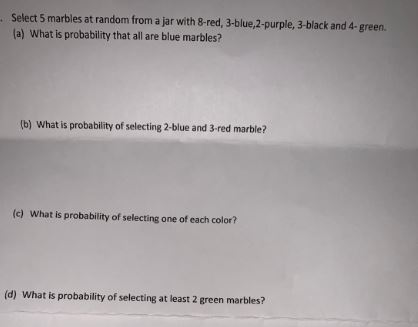Probability Colored Marbles At Least One

I at least one blue.
Probability colored marbles at least one. Calculate the probability of getting. Drawing simultaneously is the same as sampling without. When you start learning probability and statistics you can often find problems with probability urn. Two marbles are drawn simultaneously from the bag.
And then we have 3 green marbles let me draw those 3 so 1 2 3. And we write it as probability of event a and event b equals the probability of event a times the probability of event b given event a let s do the next example using only notation. A draw the tree diagram for the experiment. B the probability of getting.
Probability examples a jar contains 30 red marbles 12 yellow marbles 8 green marbles and 5 blue marbles what is the probability that you draw and replace marbles 3 times and you get no red marbles. 2 blue marbles so we have 1 blue marble 2 blue marbles. The probability of picking a yellow marble. Enjoy the videos and music you love upload original content and share it all with friends family and the world on youtube.
Two marbles are drawn without replacement from a jar containing 4 black and 6 white marbles. One red and one blue. According to wikipedia in probability and statistics an urn problem is an idealized mental exercise in which some objects of real interest such as atoms people cars etc are represented as colored balls in an urn or other container like box. What is the probability of randomly selecting a non blue marble from the bag.
So the probability of getting 2 blue marbles is. B find probabilities for p bb p br p rb p ww p at least one red p exactly one red 3. They re kind of orange ish but it does the job. Find the probability of pulling a yellow marble from a bag with 3 yellow 2 red 2 green and 1 blue i m assuming marbles.
Iii two of the same color. A a probability tree diagram to show all the possible outcomes. There are 55 marbles 25 of which are not red p getting a color other than red p 25 55 455 probability of this happening 3 times in a row is. So maybe we mix them all up and we have an equal probability of selecting any one of these.
Determine the probability that at least one is red. A bag contains 5 red and 3 blue marbles. P at least one red p rr or rb or br alternatively p at least one red 1 p no reds complementary events 1 p bb and so on. And in our case.
I at least one blue. Bag a contains 10 marbles of which 2 are red and 8 are black. P b a is also called the conditional probability of b given a. P r b or p b r or p b b.


















